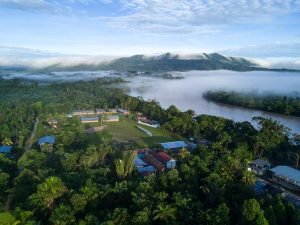Healthy Rainforest, Healthy You
5 reasons to keep rainforest around for your health
Rainforest and human health go hand in hand. Keeping these water-releasing, air-filtering medicine-cabinets standing strong is an urgent global health issue.
From key medical advances to preventing the release of unprecedented pandemics, our physical and mental wellbeing worldwide relies on trees in innumerable ways. Here’s just 5 reasons why healthy rainforest promotes healthy humans.
Our Medicine Cabinet
Rainforest are rich natural pharmacies, hiding vast amounts of known and unknown plants under its canopy. We owe a lot to this range of flora that have aided in the creation of a wide range of life-saving medicines. Many of the plants found in rainforests have already been used in the treatment of severe illnesses such as cancer, malaria and HIV/AIDs. However, there are likely masses of others with unknown potential for improving human health.
Deforestation and Disease
The degradation of rainforest by humans has been warned to be increasing rates of unknown viruses and diseases.[1]National Geographic, (2019). Deforestation is leading to more infectious diseases in humans. https://www.nationalgeographic.com/science/2019/11/deforestation-leading-to-more-infectious-disease As the preferred hosts of these pathogens are eradicated or reduced, a Pandora’s box of diseases is released on nearby populations. Deforestation and rainforest degradation can force these disease carriers to migrate closer to humans, causing disease to breakout in these populations. Protecting rainforest is essential; not only to safeguard against unknown diseases, but to preserve the natural resources that may contain the cures.
Giant Air Filters
Healthy rainforest reduces pollutants by acting as a giant air filtration system. Trees not only absorb carbon dioxide, but trap toxic pollutants such as nitrogen dioxide[2]McDonald, A., Bealey, W., Fowler, D., Dragosits, U., Skiba, U., Smith, R., Donovan, R., Brett, H., Hewitt, C. and Nemitz, E. (2007). Quantifying the effect of urban tree planting on concentrations … Continue reading, ozone and the particles produced by burning diesel[3]University of Leicester (2015). Pollution dispersion in cities improved by trees, research shows. [online] Available at: … Continue reading, cooking with charcoal and burning wood. Breathing polluted air leads to a host of health problems globally such as respiratory and cardiovascular diseases, and problems with the nervous system.[4]Kampa, M. and Castanas, E. (2008). Human health effects of air pollution. Environmental Pollution, 151(2), pp.362-367.https://www.sciencedirect.com/science/article/pii/S0269749107002849 No matter where we live, protecting rainforest is crucial in the fight against air pollution.
Floods and Drought? We’ve got a safety-net
Earth’s rainforest plays a key role come rain or shine. Storing excess rainwater, rainforest prevents extreme runoff during heavy rainfall and reduces damage when flooding does occur. It can also reduce the effects of drought by releasing stored water when levels are low. Flooding often accelerates disease outbreaks such as cholera and typhoid, and drought commonly brings poorer air quality and sometimes famine. Rainforest, and its role in the water cycle, plays a key role in protecting our health.[5]Mongabay. (2020). The impact of deforestation. [online] Available at: https://rainforests.mongabay.com/09-consequences-of-deforestation.html [Accessed 20 Feb. … Continue reading
Good for people, good for planet
Rainforests provide essential, innumerable cultural services which are complex to measure, but enrich lives around the world. Humans obtain immaterial benefits from natural ecosystems through spiritual, cultural legacy and recreational purposes. Research suggests these experiences in natural environments enable people to relax, recover and heal; both physically and mentally. By learning lessons from those who live alongside rainforest, we can learn how to respect and appreciate the immense value of healthy rainforest and find the best ways to protect it.


Cool Earth works around the world, from Peru to Papua New Guinea, helping local people keep their rainforest standing. With your support, we can scale up and share the best ways to reduce deforestation, protect wildlife and combat climate change.
References[+]
| ↑1 | National Geographic, (2019). Deforestation is leading to more infectious diseases in humans. https://www.nationalgeographic.com/science/2019/11/deforestation-leading-to-more-infectious-disease |
|---|---|
| ↑2 | McDonald, A., Bealey, W., Fowler, D., Dragosits, U., Skiba, U., Smith, R., Donovan, R., Brett, H., Hewitt, C. and Nemitz, E. (2007). Quantifying the effect of urban tree planting on concentrations and depositions of PM10 in two UK conurbations. Atmospheric Environment, 41(38), pp.8455-8467.https://www.sciencedirect.com/science/article/pii/S1352231007006140 |
| ↑3 | University of Leicester (2015). Pollution dispersion in cities improved by trees, research shows. [online] Available at: https://www2.le.ac.uk/offices/press/press-releases/2015/september/pollution-dispersion-in-cities-improved-by-trees-research-shows [Accessed 20 Feb. 2020].https://www2.le.ac.uk/offices/press/press-releases/2015/september/pollution-dispersion-in-cities-improved-by-trees-research-shows |
| ↑4 | Kampa, M. and Castanas, E. (2008). Human health effects of air pollution. Environmental Pollution, 151(2), pp.362-367.https://www.sciencedirect.com/science/article/pii/S0269749107002849 |
| ↑5 | Mongabay. (2020). The impact of deforestation. [online] Available at: https://rainforests.mongabay.com/09-consequences-of-deforestation.html [Accessed 20 Feb. 2020]. https://rainforests.mongabay.com/09-consequences-of-deforestation.html |
